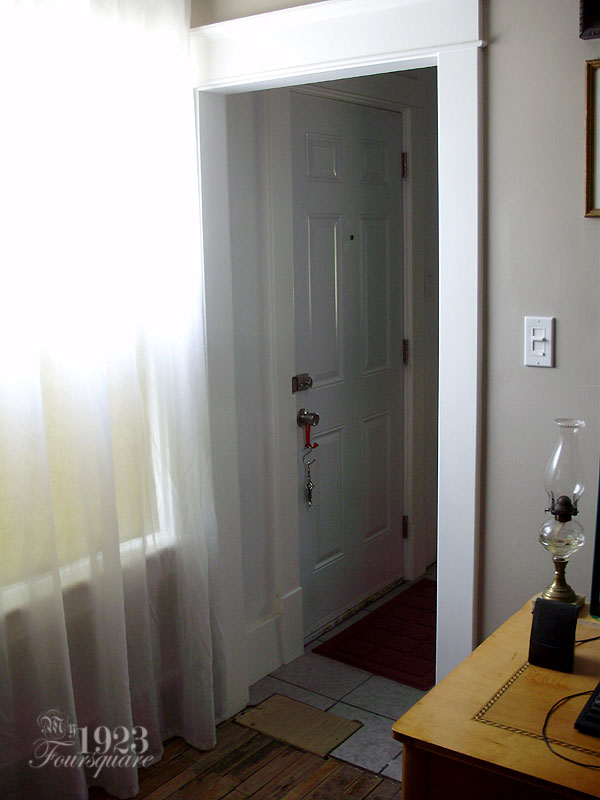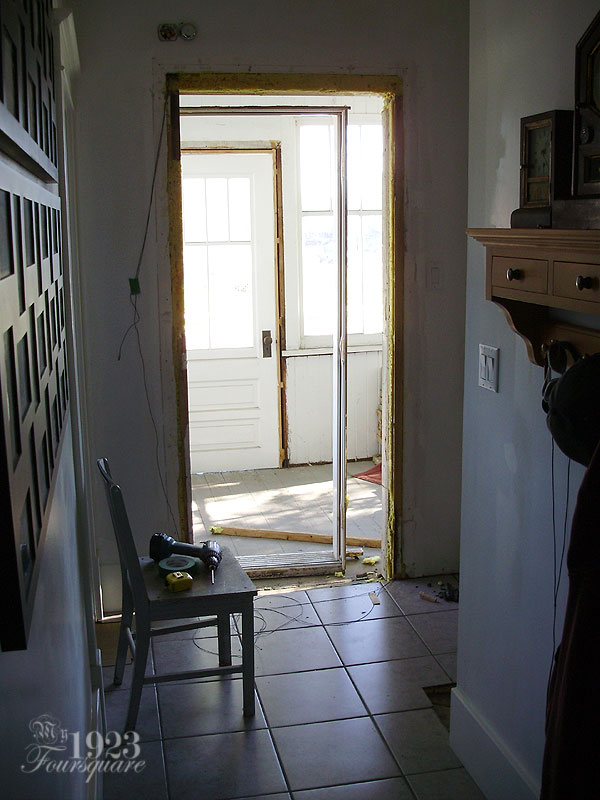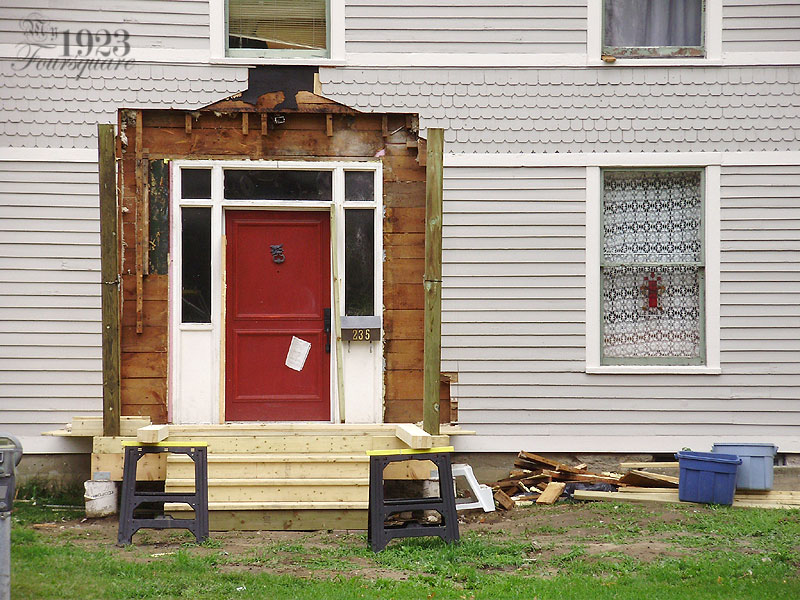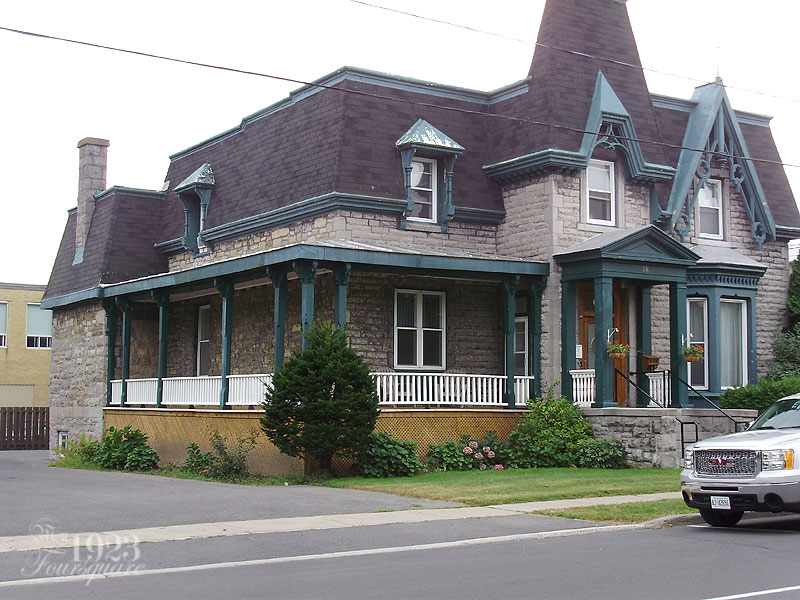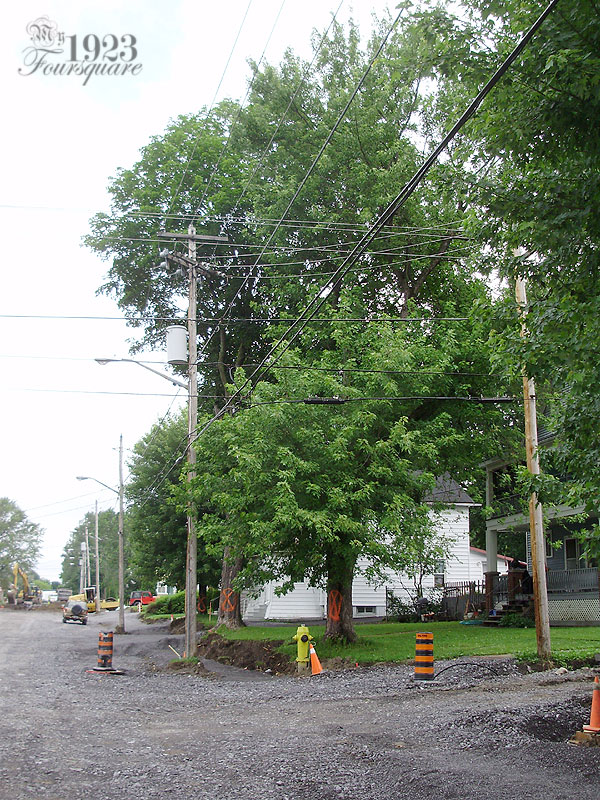Before I get into all the details of the trim work, here's a before and after showing the finished product!

Pretty dramatic, right? The white is so clean right now compared to the rest of the porch that a lot of the details are hard to make out. I know this won't last, but the porch will also need complete repainting, and it also needs restoration work to all the windows, which is a big job.
Alright, so for the trim, I wanted something very similar to what I have in the rest of the house, but a bit beefed-up (because of the size), and a bit fancier since it's the front door. I wanted it to make a statement, but still "match". I know for a fact that the original mouldings for the door would NOT have been this fancy, but there's no reason why I can't elevate them just a bit. It's not everyone who has free access to a professional trim carpenter (me), so I'm taking advantage of the situation! Haha.
The design for the trim is largely based off the trim from the "Edgewater Pad", which is a Chicago "2-flat" owned by Tate Gunnerson and his partner (http://www.strangeclosets.com/). I fell in love with their home when I first saw it a few years ago, and it was the inspiration for the paint scheme for my entire house. I posted a few photos of their place in my third post on the blog (2011) called "Inspiration".

This trim is basically the same idea as my regular trim, but instead of a small crown, the moulding is made up of a few pieces. This is a very classical design, and it dates back to ancient Roman architecture:

For the vertical side pieces, I needed a fairly wide moulding, and I looked through my stash of salvaged trim. I had one long length of trim from the hallway door casing (I talked about this in Update No.5), and then I bought an additional length for the other side.
The top's main section is simply a rectangular board with a bead moulding for a bottom division. Above this is a large cove moulding. They used to sell a nice 1" deep cove, but apparently they don't carry this anymore, and these days you're lucky if you can find close to 3/4". Seems like everything is getting smaller, crappier, and more expensive. I had to make this cove on the table saw from scratch. I just used scrap MDF (it's very messy co cut, but it was free). The crown portion is simply a 3/4" flat board with a 1/4" thick flat face piece nailed in place. The ogee moulding was just routed with a standard router bit, and this was nailed over the 1/4" strip. It's important that the 1/4" strip overhangs the bottom by a bit. Mine drops down 1/4" but it can be less. It depends how large your mouldings are. The overhang helps to make a dramatic silhouette when the light hits it. If you look at the architectural drawing (above), they use a beaded groove instead, but I prefer the overhang.

One thing that I forgot to photograph were the filler boards. If you go back to the previous post, you might be able to see that the new door jamb lands flush with the original cedar siding (meaning that there was a 3/4" deep and 2-3" wide gap in between the jamb and the edge of the siding). I added sections of 3/4" thick scrap pine boards to fill this gap (all the way around) to make everything flush before installing the plinth blocks, side pieces, and crown. For ease of installation, the entire crown assembly was nailed together and caulked before installing it. If I hadn't done this, it would have been a nightmare to try and caulk in all the gaps, especially under the 1/4" top reveal.
I designed the top to fit in place around the existing tin sheeting that was originally over the door (both to hide it, and to preserve it without needing to remove it).
For those who are curious about dimensions, the plinth blocks are 11" tall, 1" thick and 5 1/2" wide, the side columns are 5 1/4" wide (5/8" thick MDF), and the total height of the crown is around 6 1/2" with the crown protruding 3" from the edges of the flat top board. By comparison, the interior door casings in the house have 10" high plinth blocks, 4 1/4" wide side casings, and the full height of the tops are 6" with 1 1/4" projecting crowns. So the proportions are very close to the same, just a bit larger.


After sanding, primer, and lots of caulking between all the siding gaps along the sides (use acrylic/painter's caulking), and after 3 coats of white:

The threshold and small moulding in the centre base will eventually be painted grey to match with the porch floor (and because white will be too hard to keep clean). For now, it will stay white until I redo the porch floor/interior.

Again, since everything is so clean and bright it's hard to see all the moulding details. I like how the side casings match the look of the window trim from the door.

I couldn't get the whole door in one shot (The first photo at the top of this post was stitched together).



It was nice to finally install the doorbell nice and neatly. It was fully functional before, but I had just hacked away at the moulding to make it fit since I knew I'd be scrapping it and redoing it later. The original installation also used big ugly screws (the ones provided), and this time I found two smaller slot-head screws in brass to match.
I love the old wavy glass in the door!

This photo shows off the mouldings the best.






